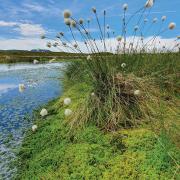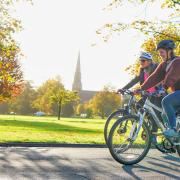We all know Yorkshire is a very special county – from our rolling hills and dales to our white chalk coast, our thriving and diverse urban centres, our famous cheese and Yorkshire puddings, love of tea, and our strong regional pride.
Although sometimes overlooked, our wildlife is something many of us have always been proud of – and now the science confirms just how important Yorkshire is. The first-ever State of Yorkshire’s Nature report, compiled by leading conservation charity Yorkshire Wildlife Trust using data from several conservation organisations, has done a deep-dive into how our birds, mammals, plants and moths are faring across our great and green county – and what we can do to make Yorkshire’s wildlife flourish.

Yorkshire – home of the wild
The headlines show that Yorkshire is an important home for British wildlife. Two-thirds of all British species are found in Yorkshire – that’s between 40,000 and 50,000 different species. Some plant species - thistle broomrape and Yorkshire sandwort – are so rare that they are only found in Yorkshire, and we also have England’s only population of dark bordered beauty moths.
There are declines happening, as environmentalists have increasingly been warning us. The report estimates that nearly 2,000 species may have disappeared from Yorkshire over the last 200 years - 1 in 20 of Yorkshire’s larger moths and plants - and a further 3,000 are at risk of extinction. Over 300 species of birds, plants and moths are ‘Yorkshire Species of Concern’: species which are nationally threatened, rare and declining in Yorkshire, and/or have a large part of their range or population in Yorkshire.
Yorkshire has some amazing wildlife – in many cases it is rare and declining, and often supporting nationally significant populations – but we are losing this unique wildlife in favour of more common species. In time, there is the danger that Yorkshire’s biodiversity could become just like everywhere else.

Hope for the future
There is hope. The report highlights the importance of maintaining a broad range of habitats to sustain the full range of Yorkshire’s species, and identifies three key habitats where conservation and restoration efforts will bring important biodiversity and environmental benefits.
Limestone habitats are especially rich in Yorkshire. Almost half of the plants of conservation concern grow on limestone or chalk soils, and more than half of the UK’s limestone pavement and upland limestone grassland is found here, as well as the UK’s most northerly chalk streams – of which there are less than 200 worldwide.
Wet habitats – Yorkshire has seen significant wetland loss through drainage and river canalisation, and less than 20% of rivers in Yorkshire are in a healthy state. Almost half of the plants that have disappeared from Yorkshire grew in wet habitats and some of our most obvious conservation successes are where they have been restored. Bringing water back onto the land will have substantial biodiversity benefits.
Marine habitats - the chalk cliffs on the Flamborough and Filey coast support the largest mainland breeding seabird colony in the country, and the Humber Estuary is an internationally-important stop-off for waders, wetland birds and migratory species. The reef habitats at Flamborough are the most diverse in the UK, and the kelp beds there are part of a larger area which soaks up over 1,300 tonnes of carbon a year.

Building a greener Yorkshire
Over the next year, Yorkshire Wildlife Trust will be producing a region-wide plan for nature recovery which will look at setting out a way forward for our habitats, wildlife – and for us. The State of Yorkshire’s Nature report will also be used in the development of Local Nature Recovery Strategies, and to map a future for Yorkshire’s wildlife in policies and decision making.
Yorkshire Wildlife Trust is calling for:
Councils, landowners and managers, and organisations with a role in caring for our landscape to use this report and work together to protect a higher percentage of Yorkshire’s landscape for nature.
Local people to hold their local councils, MPs and councillors accountable to any green pledges they made during the run up to the general election, and to creating more, bigger, better and joined up green space for all.
Communities to join together to create more green space for their local nature - in their back gardens, in community spaces, on verges and in public parks. Joining Yorkshire Wildlife Trust’s #TeamWilder initiative is a great place to start!
Support for the Trust via a donation or becoming a member. Our 45,000 members help our region’s wildlife thrive – and the impact their support makes has never been clearer.
ywt.org.uk



























